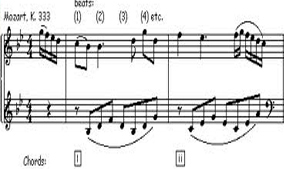Lesson 1 - Basic Melodic Principles

A good melody, like a good house, has a solid basic framework. This is then embellished and refined to create more interest. When creating a melody, composers often start with a rhythmically simple line according to the following guidelines, then add the embellishments later. A full understanding of common practice melodic guidelines is essential for writing and understanding these melodies.
1) Rhythm - keep it simple to start with. A good guideline is one note per beat or pulse.
2) Contour - this is the shape of the line. Usually, there is only one highest or lowest note, called the peak. If the peak note is repeated, it looses it's effect, so it is important to have only one peak to your contour. Where should the peak occur?
Although there is an infinite number of variations, there are several basic contours that melodic lines generally follow:
a) Arch - the most popular contour. Begins lower, works its way up to a high point between around or just after the midpoint of the melody, then falls back to a lower ending note. All of the following are arch contour melodies:


An Inverted Arch contour simply flips this shape upside-down, with the lowest peak occurring only once.

b) Ramp - Melodies often save the high or low peak for the last note, for a more climactic ending. An ascending ramp contour begins at or near the lowest not, and gradually and continually works it's way up to the highest peak. a descending ramp contour reverses this, beginning with the higher point, and ending with the lowest.
Ascending Ramp

Descending Ramp

Remember, these are simplifications. Melodic lines may briefly zig-zag around these shapes, and sometimes may combine both. This familiar melody has both arch contours and descending ramps:

It is important to note, however, that lines without a contour often sound dull and seem to just "noodle around" on a few notes. Compare the above melodies to the following, and see which is the more interesting:

3) A Smooth Connected Line - Our ear more easily hears a series of notes as belonging together when they proceed smoothly and without leaps of larger intervals. The following are the main guidelines used in common practice melodic lines:
a) Use about 80% step wise motion (i.e. only the interval of a second) and 20% intervals large than a second.
b) Avoid using augmented or diminished intervals, as they are harder to sing, play, and hear as belonging together.
c) Whenever leaping an interval larger than a fifth, resolve inward by step. (for example, if you leap down a sixth, the next note should resolve up by second.)
4) Resolve tendency tones - Scale degree seven has a tendancy to resolve to tonic, unless part of a downward scale passage from tonic to dominant.
a) Scale degree four has a tendancy in Major to resolve down to scale degree three.
b) Chromatically altered pitches should resolve by step (the interval of a second) in the same direction as the alteration. For example, added sharps should resolve upward by step, and added flats should resolve down by step.
Note the examples of the above guidelines in the following two melodies -- the first follows them, and the second does not.
Melody which follows guidelines:
 Melodies that does not follows guidelines:
Melodies that does not follows guidelines:
 Back to Lessons.
Back to Lessons.
A variety of ways to shape your Melody!
Contours dictates the shape of the melody thus creating interest.
Skills Set to Master
Essential knowledge of major scales increases your knowledge and facility of creating melodies.
Minor ScalesAnother powerfull tool. Just like the major scales, the minor scales gives you additional color and versatility of your melodies.
